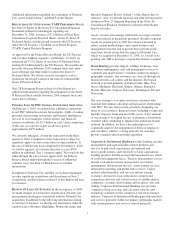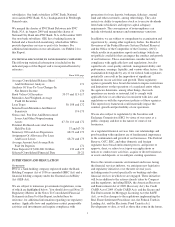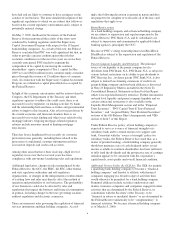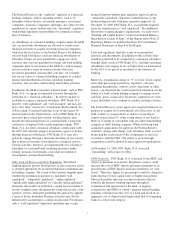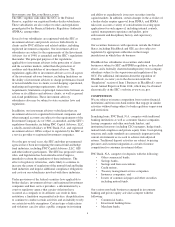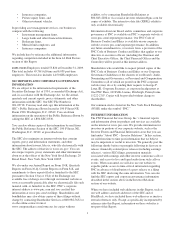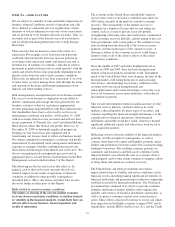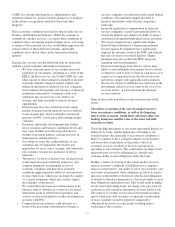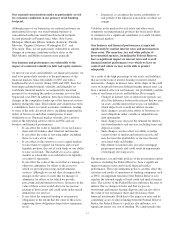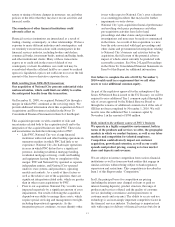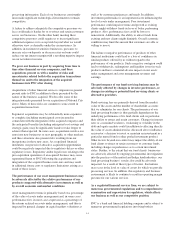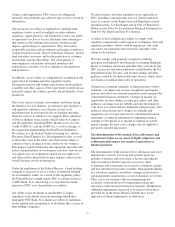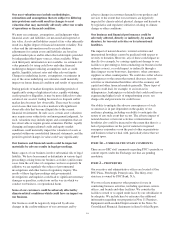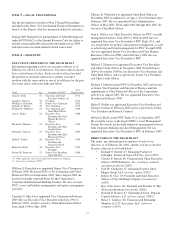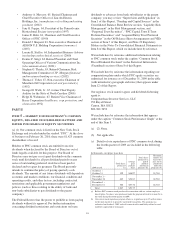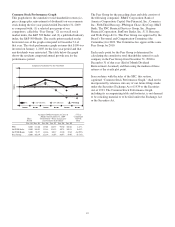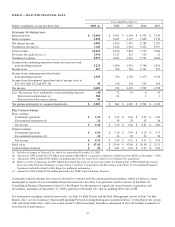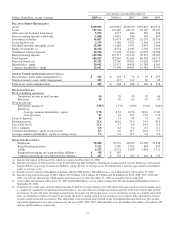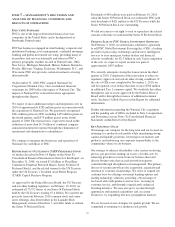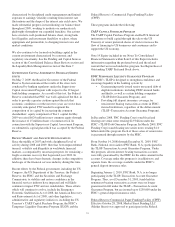PNC Bank 2009 Annual Report Download - page 17
Download and view the complete annual report
Please find page 17 of the 2009 PNC Bank annual report below. You can navigate through the pages in the report by either clicking on the pages listed below, or by using the keyword search tool below to find specific information within the annual report.
nature or timing of future changes in monetary, tax and other
policies or the effect that they may have on our activities and
financial results.
The soundness of other financial institutions could
adversely affect us.
Financial services institutions are interrelated as a result of
trading, clearing, counterparty, or other relationships. We have
exposure to many different industries and counterparties, and
we routinely execute transactions with counterparties in the
financial services industry, including brokers and dealers,
commercial banks, investment banks, mutual and hedge funds,
and other institutional clients. Many of these transactions
expose us to credit risk in the event of default of our
counterparty or client. In addition, our credit risk may be
exacerbated when the collateral held by us cannot be realized
upon or is liquidated at prices not sufficient to recover the full
amount of the loan or derivative exposure due us.
Risks resulting from 2008-2010 transactions
Our acquisition of National City presents substantial risks
and uncertainties, which could limit our ability to realize
the anticipated benefits from this transaction.
On December 31, 2008, we acquired National City through a
merger in which PNC continued as the surviving entity. We
provide additional information about this acquisition in Note 2
Acquisitions and Divestitures included in the Notes To
Consolidated Financial Statements in Item 8 of this Report.
This acquisition presents us with a number of risks and
uncertainties related both to the acquisition itself and to the
integration of the acquired businesses into PNC. These risks
and uncertainties include the following risks to PNC:
• Like PNC, National City was a large financial
institution with retail and other banking operations in
numerous markets in which PNC had little or no
experience. National City also had major operations
in areas in which PNC did not have a significant
presence, including residential mortgage lending,
residential mortgage servicing, credit card lending
and equipment leasing. Prior to completion of the
merger, PNC and National City operated as separate
independent entities, and National City operated
under its own systems and procedures, operating
models and controls. As a result of these factors as
well as the relative size of the acquisition, there are
significant integration-related risks, which are greater
than in other recent acquisitions by PNC.
• Prior to our acquisition, National City’s results were
impacted negatively by a significant amount of asset
impairments. Our results following the acquisition
depend on our ability to manage these assets, which
require special servicing and management oversight,
including disposition if appropriate. As the
integration process continues, we may identify other
issues with respect to National City’s asset valuation
or accounting procedures that may lead to further
impairments or write-downs.
• National City’s pre-acquisition financial performance
and resulting stock price performance and other
pre-acquisition activities have led to legal
proceedings and other claims and governmental
investigations and more may be made or commenced
in the future. As a result of this acquisition, we now
bear the risks associated with legal proceedings and
other claims and governmental investigations relating
to National City’s business and activities before the
acquisition, the full extent of the potential adverse
impact of which cannot currently be predicted with
reasonable certainty. See Note 24 Legal Proceedings
in the Notes To Consolidated Financial Statements in
Item 8 of this Report for additional information.
Our failure to complete the sale of GIS by November 1,
2010 would result in a requirement that we sell other
assets or raise additional common equity.
As part of the regulatory approval for the redemption of the
Series N Preferred Stock issued to the US Treasury, we will be
required to raise additional Tier 1 common capital through the
sale of assets approved by the Federal Reserve Board or
through the issuance of additional common stock if the sale of
GIS has not been completed by November 1, 2010. We will
need to raise this additional Tier 1 common capital by
November 1 in the amount of $700 million.
Risks related to the ordinary course of PNC’s business
We operate in a highly competitive environment, both in
terms of the products and services we offer, the geographic
markets in which we conduct business, as well as our labor
markets and competition for talented employees.
Competition could adversely impact our customer
acquisition, growth and retention, as well as our credit
spreads and product pricing, causing us to lose market
share and deposits and revenues.
We are subject to intense competition from various financial
institutions as well as from non-bank entities that engage in
similar activities without being subject to bank regulatory
supervision and restrictions. This competition is described in
Item 1 of this Report under “Competition.”
In all, the principal bases for competition are pricing
(including the interest rates charged on loans or paid on
interest-bearing deposits), product structure, the range of
products and services offered, and the quality of customer
service (including convenience and responsiveness to
customer needs and concerns). The ability to access and use
technology is an increasingly important competitive factor in
the financial services industry. Technology is important not
only with respect to delivery of financial services but also in
13


